Archive for the ‘K Schwitters’ Category
Monday, June 9th, 2014
“We need a little confusion.”
— Neil Gaiman
The Great American Brass Band Festival’s milestone 25th event is now in the archives. The finale was one of the most satisfying concerts in the history of the Kentucky festival. My appreciation goes to those who made it all happen one more time! I am pleased to have played a small part.
When I was first approached about lending my creative experience to the effort, I pitched the idea of a traditional collage to mark the 25th, using scraps from memorabilia of the last quarter century. A decision was made to go a different direction, but I could not put the idea aside. The result is “Brass 25,” a tribute to my community’s exceptional contribution to the American musical and cultural scene.
Is “commemorative collage” art? Perhaps not. Some might make the case that no example of the medium has approached “high art.” In my opinion, such a viewpoint fails to consider the 100-year impact that the medium has had on our visual landscape and the evolution of our aesthetic perceptions. It neglects the seminal role of Schwitters, Höch, Cornell, Kolář, and others. For me, the core relationship between mundane material and the art of collage transmits a unifying principle. When the remnants of ordinary life are physically re-purposed to resolve a unique compositional harmony, the culminating artifact can achieve a transcendent tone and offer a shared experience with each participating observer. If that is not art, stripped of elitist notions, then what is?
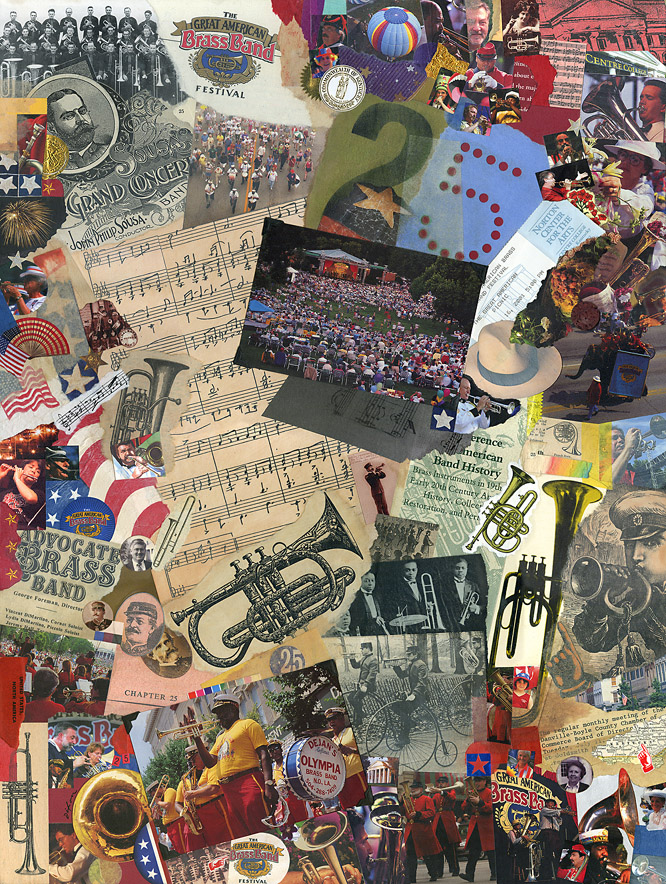
Brass 25
commemorative collage by J A Dixon
17.5 x 23.5 inches
available for purchase
Posted in 1) Available!, Applied Arts, Collage, H Höch, Illustration, Influences, J A Dixon, J Cornell, J Kolář, K Schwitters, Larger Works, Methodology | No Comments »
Wednesday, April 30th, 2014
“To alcohol: the cause of, and solution to, all of life’s problems.”
— Homer Simpson
Yesterday was my birthday, and I was rocked by the generosity of a fellow practitioner, Ted Tollefson. A veteran collaborator, he is also one of the more versatile individuals currently laboring in the medium. Like many collage artists, Tollefson explores a number of different approaches, but has recently established his mastery of the collage-on-beer-coaster format.
I was not fully aware until today that he has been producing a coaster-based collage for each of his facebook friends. That means hundreds of miniatures in a relatively short time frame, and, from what I can tell, he calibrates the visual method for each intended recipient. Given my expressed fondness for personal miniatures, TT is a kindred spirit indeed. He has crafted a real gem for my gift coaster. Everything about it — scale, colors, composition, textures, choice of ingredients — are simply outstanding. Thank you, sir, for your kindness. Keep up the superb effort. You are a true heir to Kurt Schwitters. Merz lives!
Take a look at just a few examples of his creative output and you might share my high regard for this mushrooming body of intriguing work.
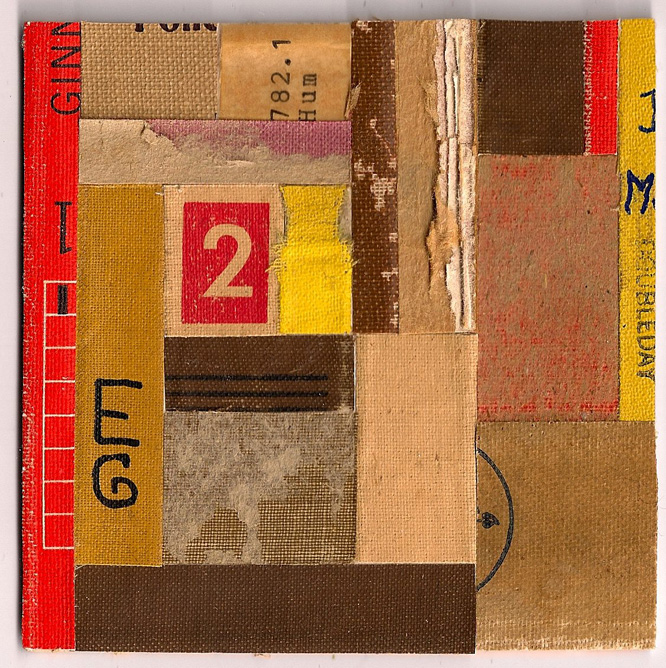
April 29
collage on beer coaster
by T Tollefson for J A Dixon
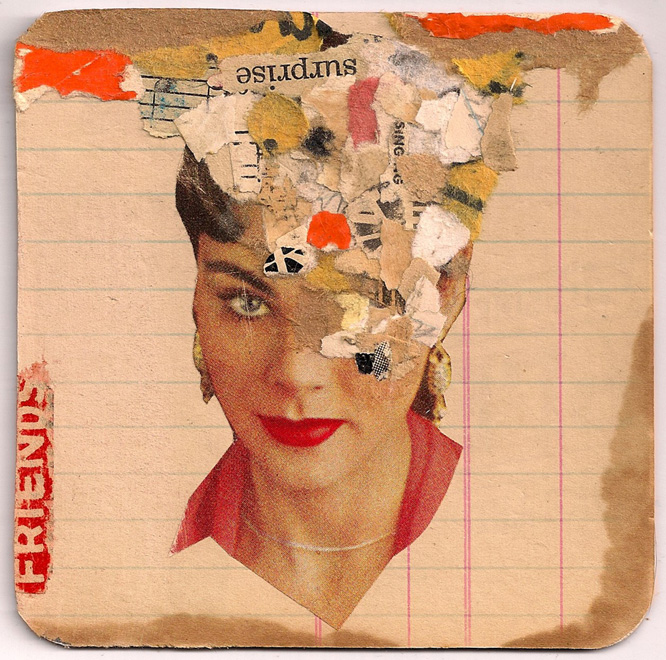
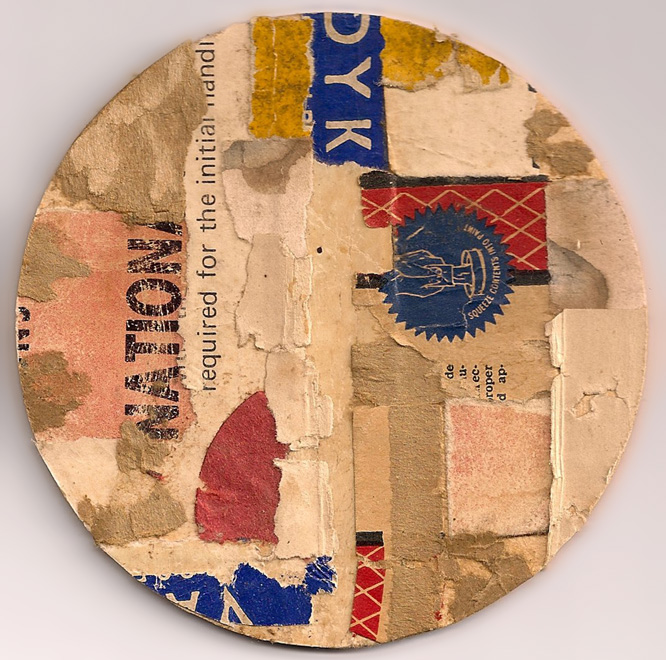
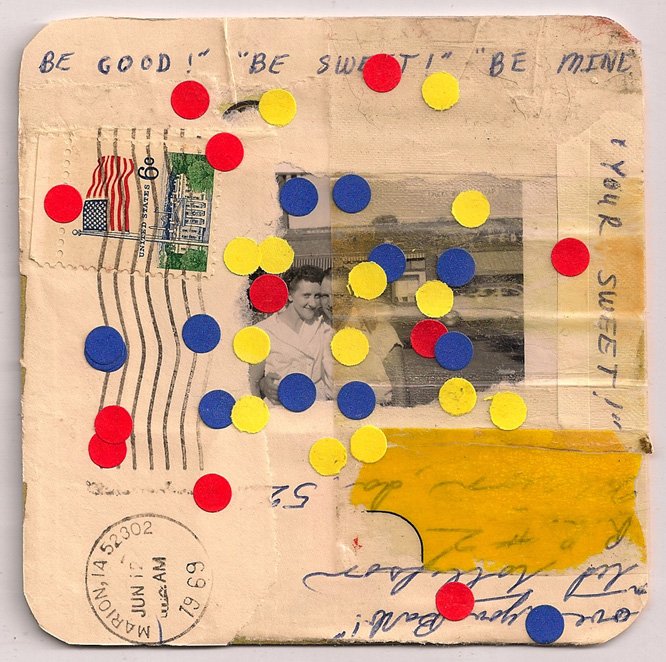
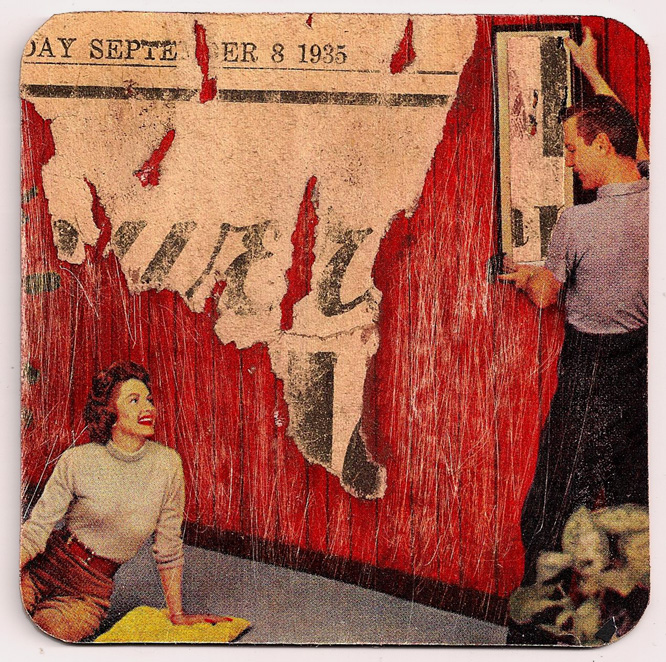
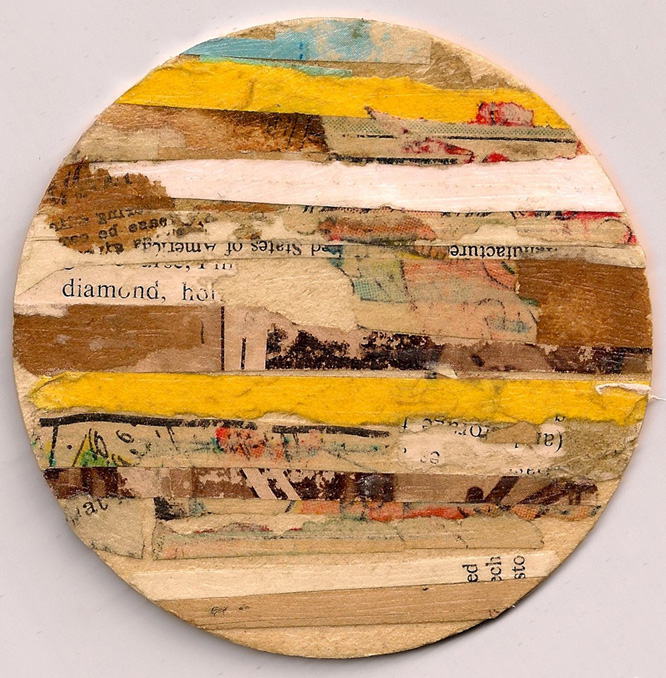
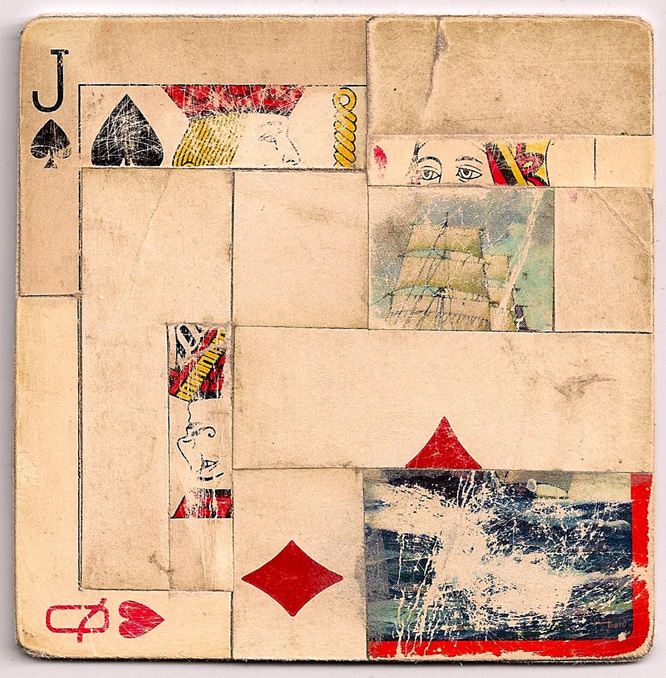
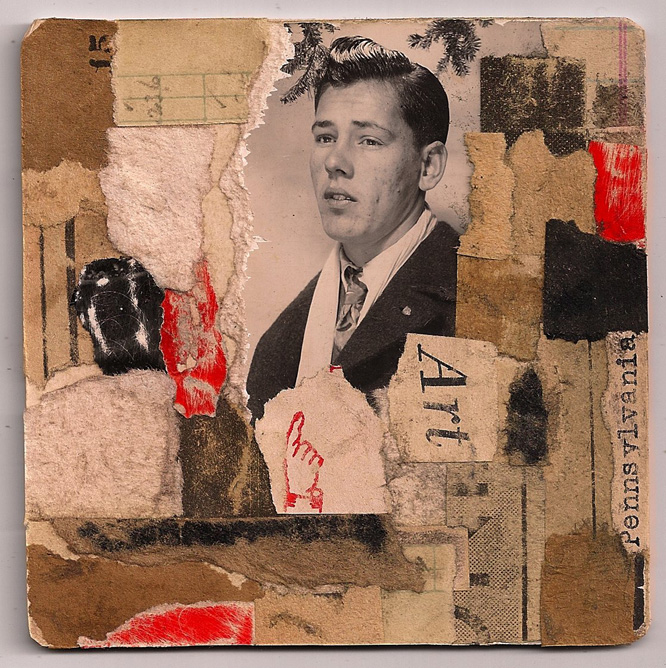
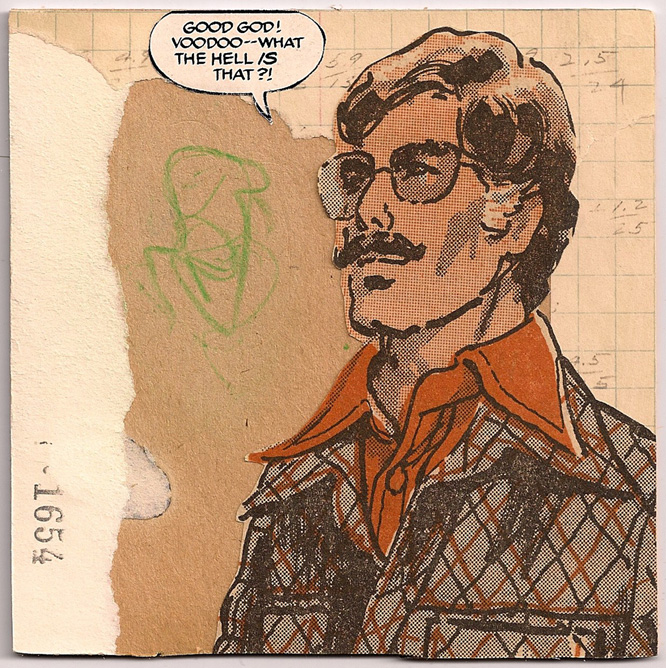
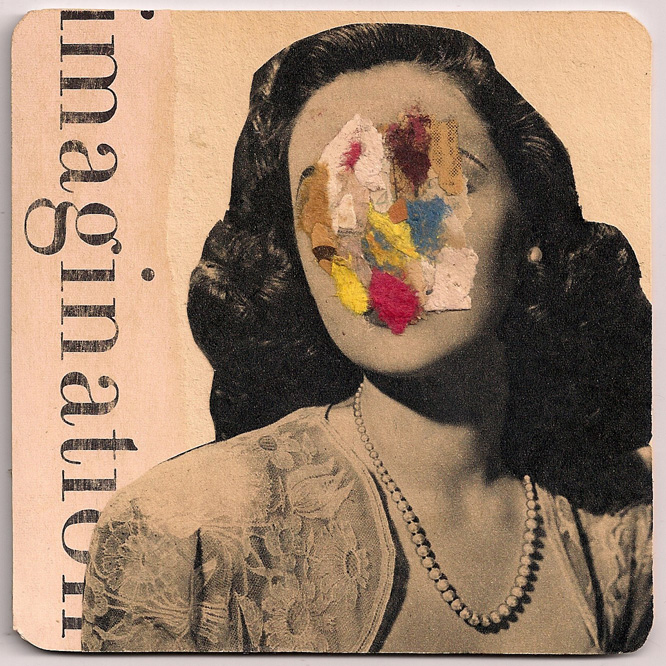
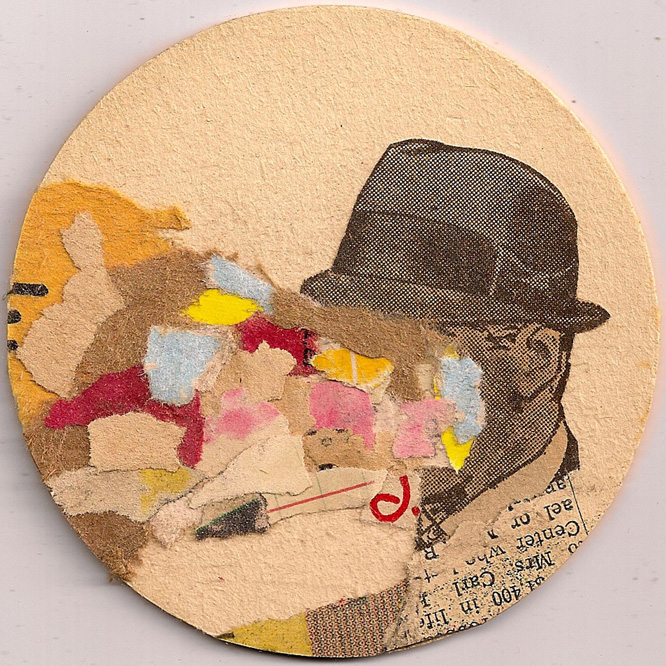
Personal miniatures on beer coasters by Ted Tollefson.
(Hover over image for more information; click to view larger.)
Posted in Artifacts, Gift Art, K Schwitters, Merz, T Tollefson, Technique, Theme/Variation | No Comments »
Saturday, August 10th, 2013
“But now I had these targets, and something grand in me wanted to make the two divergent threads — one of my artwork, one of my father — intertwine.”
— Laura Tringali Holmes
An increasingly engaging form of collaboration in collage is the coming together of a diverse group to explore the shared concept. In my last post we looked at an example in which the participants artistically exploited an image or thematic suggestion. Today we feature a remarkable project launched by L T Holmes that makes use of nearly identical vintage paper targets she has magnanimously provided to those taking part. Anyone reading this is urged to investigate her recent blog entry that offers an affecting backstory for the “Target Practice” initiative.
As this outstanding series takes shape, I cannot help but think of the Merz painting, “Hitler Gang,” and how KS (as usual) was just a bit ahead of us. If he thought a target was a cool collage ingredient nearly 70 years ago, I am, for one, quite content to continue digging the ground he broke. At least we are not fearing for our personal safety, thank heaven.
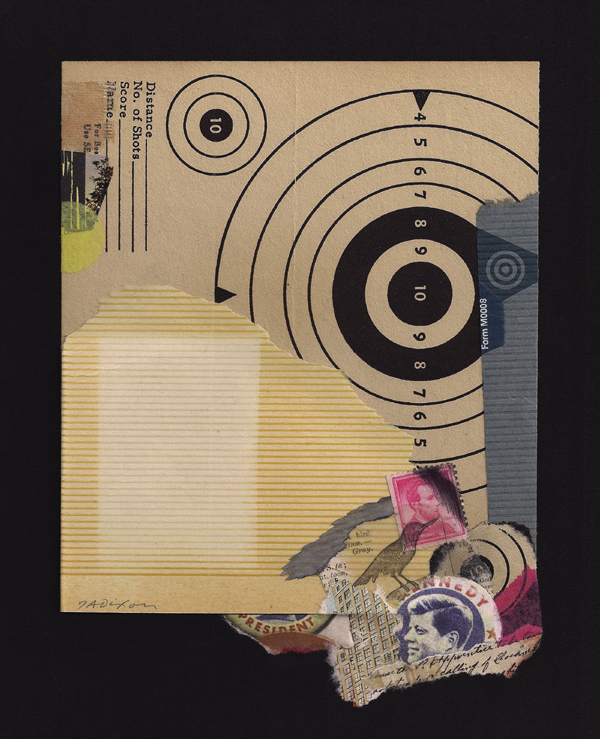
Friday, 1963
collage miniature by J A Dixon
vintage target from L T Holmes
6 x 7 inches
Purchase this artwork!
Posted in 1) Available!, Collaboration, Ingredients, J A Dixon, K Schwitters, L T Holmes, Merz, Theme/Variation | No Comments »
Friday, July 12th, 2013
“Any fool can carry on, but only the wise man knows how to shorten sail.”
— Joseph Conrad
Looking back on a full year as a blogger, many of my initial objectives have been met, but there are even more subjects to tackle in the coming months. Can I find the right balance between words and images, welcoming others to act as better scribes for what is happening in collage and remembering that I would rather be holding a pair of scissors than typing at a keyboard? The exceptional print quarterly out of Canada, Kolaj, has also celebrated its first birthday. 2012 was the perfect year to salute a century of collage as a modern art and also to look around, assessing the current maturity of the practice. I still have much to say about the pioneers and exemplars — Gris, Schwitters, Hausmann, Höch, Cornell, Hamilton, Johnson — for there is much to observe and absorb about their seminal talismans and bodies of work.
It is equally important to evaluate more of the leading and emerging artists now actively producing what may be known as “post-centennial collage,” perhaps the most vital period of cross-pollinated output in the medium’s history. Where to focus next? Those who magnify the traditions of Dada, Surrealism, Fluxus, or Layerism? Dedicated collage abstractionists such as Touchon, Dryden, Romoff, or Gordon? Masters of the outer reaches of a Maximalist/Minimalist spectrum such as Kroll, Reitemeyer, or De Blauwer? I have for some time lamented the lack of a visual-arts phenomenon equivalent to how musicians have traditionally improvised together, but my recent awareness of dynamic collaborations between collage artists is forcing me to change my mind. Is it time for me to take a closer look at the creative fusions instigated by Collins, Holmes, Daughters, or Wilkin?
My, my . . . have we just laid out another year or more of entries? And I have not yet “scraped the working surface” of all the collage artists who make the contemporary scene so exciting. Do I possess the necessary wisdom to tame my ambitions and “shorten sail?” My mind rebels at the idea that I cannot be an artist and a writer, too. I am no scholar, and some art historians would scoff at my correlations, but I cling to the notion that there is a place for insights about our medium that can come only from a person who faces the same challenges as my working peers when confronting a pile of scrap.
One more thought: As the digital age sweeps over the planet, is there also taking place a not-so-quiet backlash against the erosion of manual dexterity? If so, is there a more compelling counter-trend example than the current explosion of tearing, cutting, assembling, transferring, and pasting? And beyond the familiar “analog” technique, what can be said about the deep influence of visual collage on the preponderance of montage in all things sensory — music, performance, film, and media design? This site can become a place where all of this is explored, discussed, shared, and challenged. Much of that is up to you, valued reader. Meanwhile, I shall continue to see, write, and make more art. Stop by again, soon!
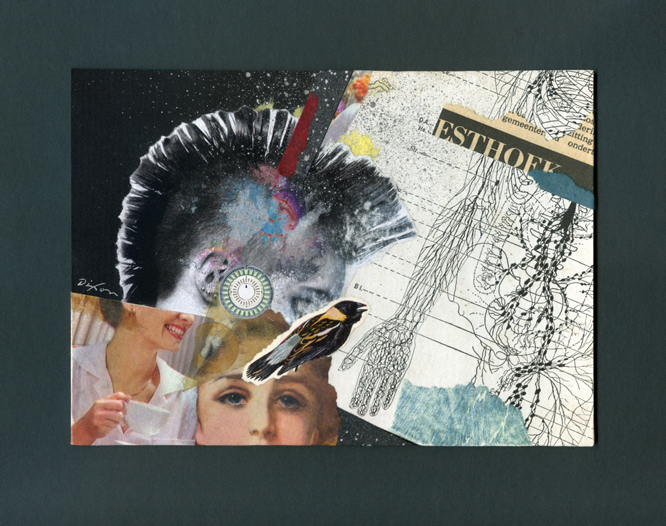
Every Instinct of My Being Rebels
collage miniature by J A Dixon
7 x 5 inches
Purchase this artwork!
Posted in 1) Available!, Artists/Collage, Blog Years, C Touchon, C Wilkin, Collaboration, Collage, D Daughters, Dada, Fluxus, H Höch, H Kroll, I Reitemeyer, Influences, J A Dixon, J Cornell, J Gris, K De Blauwer, K Schwitters, L Romoff, L T Holmes, Layerism, Links, Maximalism/Minimalism, Music, Publications, R Hamilton, R Hausmann, R Johnson, R K Kadour, S Gordon, Surrealism, T Dryden, Z Collins | No Comments »
Sunday, June 30th, 2013
“Transforming nothing into something is something of course, but because it’s a metaphor (let’s say it’s a reflection of life and death), doesn’t mean it’s especially important.”
— Matthew Rose
Is a pizza fundamentally more satisfying than a beer?
Perhaps this question is a peculiar way of following up on my previous post. The subject of maximalism and minimalism in collage is worth continuing, and I readily admit that our topic would benefit more from an interactive discourse than a single voice, but such is the nature of a blog that has yet to gain a participatory following. Nevertheless, I cannot drop the discussion without further remarks and, in particular, some worthy examples of each methodology.
Getting back to the opening query . . . There is nothing more inviting on a hot summer evening than a cold beer after a day of effort. It can immediately lose its appeal if flat or flavorless. A slice of pizza will look much better — steaming, fragrant, and loaded with toppings — but not if it is dry, overdone, or charred underneath. What I am trying to suggest with this oddball reference is the idea that a simple thing or a complex thing is not necessarily better than the other. It is all about how each is presented. And the most meaningful conclusion may be that both are enhanced when the two exist together. Whether you investigate Picasso, Braque, or Schwitters, it is clear that they thought of collage as an extension of painting, and how can one say that maximalism or minimalism in painting takes supremacy over the other? One cannot, of course, and either method is more interesting when the entire scale of approaches to the medium are continually explored (in some cases by the same artist). So, returning to my feeble analogy, we recognize that the combination of “good stuff” determines a synergistic effect. Collage as an art form is more vital today as a result of this diversity of orientation.
Our medium does not exist in a vacuum. Maximalism, minimalism, and everything in between is rooted in the movements of Dada, Surrealism, Constructivism, Expressionism, and Popism. One contemporary collage artist with a keen awareness of these influences is the “American in Paris,” Matthew Rose. He has created masterful works at multiple points in the spectrum of complexity, and a few examples appear below. In future entries, we shall feature other artists who probe minimalism and maximalism in collage.
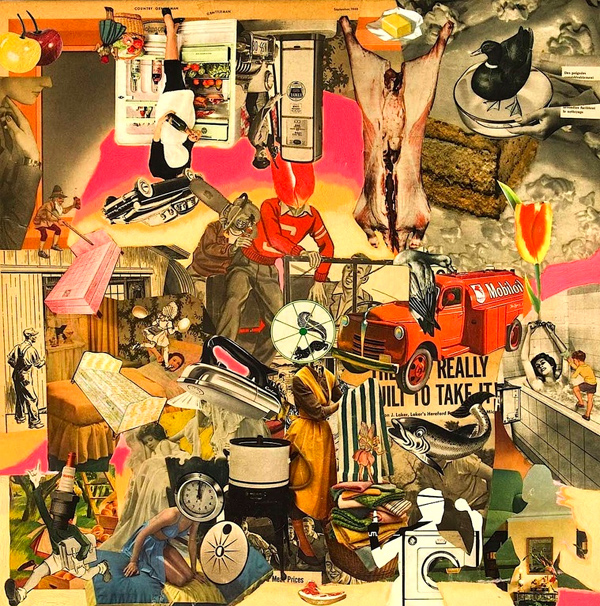
The End Of The World
Matthew Rose, 2008
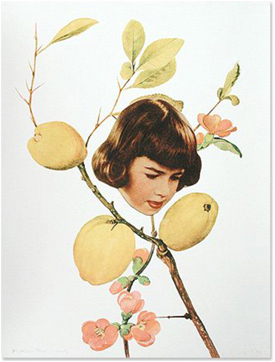
Immaculate Perception
Matthew Rose, 2010
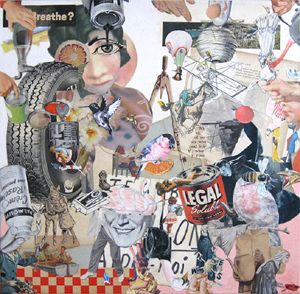
Breathless
Matthew Rose, 2010
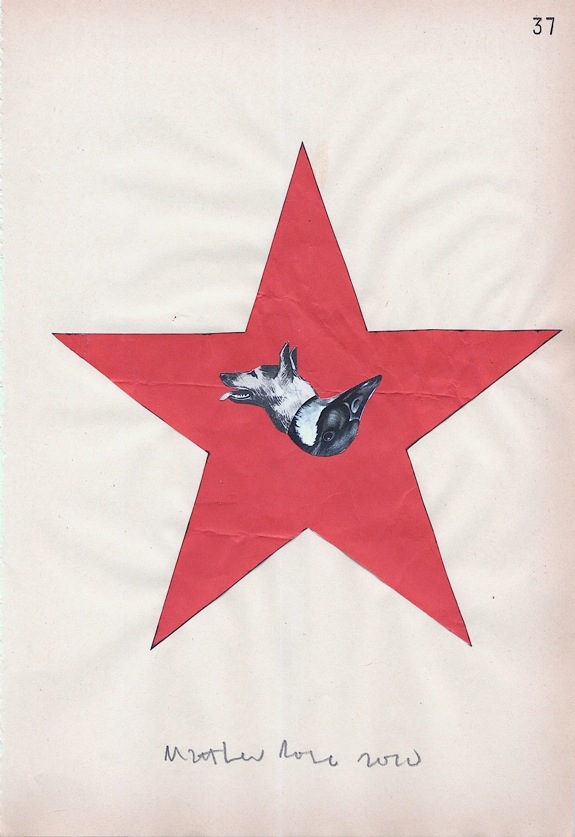
China Star
Matthew Rose, 2010
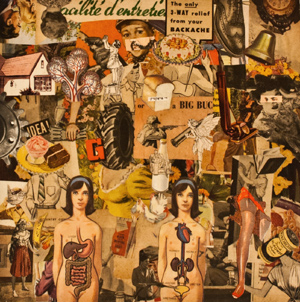
Experience
Matthew Rose, (date unknown)
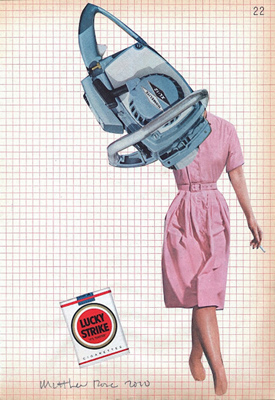
Lucky Strike
Matthew Rose, 2010
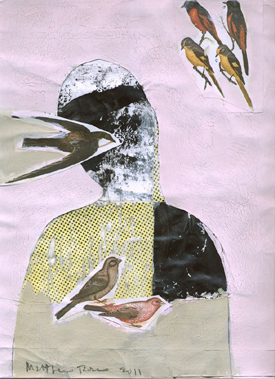
Self Portrait
Matthew Rose, 2011
Posted in Collage, Combined Mediums, Constructivism, Dada, Expressionism, G Braque, Influences, K Schwitters, Links, M Rose, Maximalism/Minimalism, Methodology, P Picasso, Pop Art, Portraits, Surrealism | No Comments »
Monday, June 24th, 2013
“Less is not necessarily more.”
— Milton Glaser
A profusion of collage artwork has recently come to my attention that makes use of only two or three elements. When this type of minimalist approach is successful, the result can be quite arresting to the eye and mind. More often than not, it looks uninteresting or unfinished to me. It may come as no surprise that I am more of a maximalist, preferring to build a layering of ingredients that transcends the intrinsic quality of the found material. I suppose that I have been more influenced by Schwitters than Cornell. Although there is nothing inherently unappealing to me about “sparsity,” admiring those who employ the methodology with skill, I have found myself pulled toward “density’ for the past few years. Some artists may think that if one hasn’t achieved a solution with fewer than a dozen parts, the essence of the piece has escaped. I appreciate that viewpoint, and respect those who consistently meet the challenge of limitation. For me, the working surface calls out for more, until a balance of “visual polyphony” takes form, and the dynamic aspects of color, shape, composition, and symbolic communication have resolved themselves as a distinctive, unified whole.

Fallen Body
collage artifact by J A Dixon
7.5 x 10.5 inches
available for purchase
Posted in 1) Available!, Artifacts, Collage, Influences, Ingredients, J A Dixon, J Cornell, K Schwitters, Links, M Glaser, Maximalism/Minimalism, Methodology | No Comments »
Sunday, April 7th, 2013
“I’ve never met a tradition that is not the result of successful invention. As soon as you invent something that everybody wants, unless you evolve that tradition, it starts to get smaller. I think of the Silk Road, in many ways, as the Internet of antiquity. Today it’s much faster but we had essentially the same results. When people met at the borders, you traded; you figured out who you are; do I trust you? Can we do business together? Can we be friends?”
— Yo-Yo Ma
A week after finishing my 31-miniatures-in-31-days exercise, which culminated in a “Silk Road” collage series, I am able to look at the month’s output with a bit of perspective. A period of sustained experimentation collided with a catalytic event (attending a performance of the Silk Road Ensemble with Yo-Yo Ma), and suddenly I was off on a ride of intense thematic exploration. I am now able to link the end result to a piece I created seven years ago as a tribute to Kurt Schwitters. I felt strongly at the time that by transcending the individual characteristics of ingredient elements, the totality of a compositional effect could take on a reverential tone. I have nothing against irreverence, satire, or sarcasm in art, but I am increasingly comfortable with the idea that when I step beyond an inspirational experience, my natural tendency is to seek beauty, harmony, and perhaps even “the sacred” in a work of collage.

Sacred Ode To Merz
J A Dixon, 2006
homage to K Schwitters
16 x 20 inches (framed)
private collection
Posted in Artists/Other, Experiments, Influences, Ingredients, J A Dixon, K Schwitters, March Exercise, Merz, Silk Road Series, Y-Y Ma | No Comments »
Monday, February 25th, 2013
“Time consecrates and what is gray with age becomes religion.”
— Friedrich Schiller
The collage artworks of Kurt Schwitters possess a “vintage” appearance to our eye, but it is essential to keep in mind that his “Merz” ingredients were predominantly gleaned from a concurrent environment. It was Joseph Cornell, via the influence of Max Ernst and others, who consciously selected antique images to reinforce the romance and melancholy of feelings past. Apparently, a significant number of active collage artists limit their resources to vintage found material. Don’t get me wrong; I love this work. The immediate “retro effect” can be quite compelling. It would take a stronger soul than mine to dismiss the inherent dignity that comes with the marvelous scrap from an outdated encyclopaedia or the now-funky gravitas of post-war, mass-market magazines. However, from my perspective, a vital element of contemporary collage is the incorporation of present-day material and the recycling of twenty-first century detritus. I find it even more interesting to see vintage ingredients effectively juxtaposed with the ephemera of our own time. Nevertheless, every serious artist has a set of aesthetic considerations, genre goals, and process parameters that mold decisions. Due respect should be extended to the overall objectives that each collage artist brings to this exceptionally diverse media.
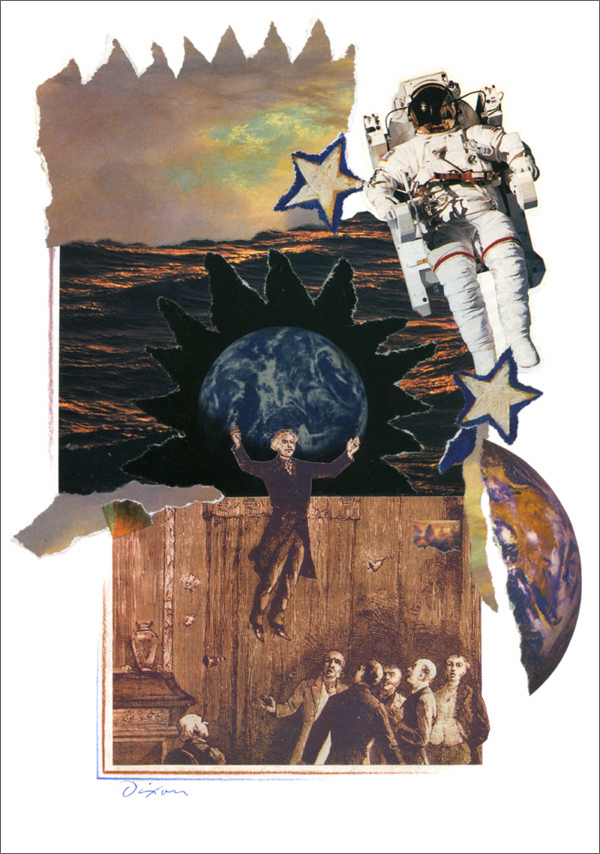
Untitled (Just Another Prophesy)
journal collage by J A Dixon
8.5 x 11 inches, not for sale
Posted in Collage, Experiments, Influences, Ingredients, J A Dixon, J Cornell, Journal, K Schwitters, M Ernst, Merz, Methodology, Priorities | No Comments »
Monday, February 11th, 2013
“From the beginning he had responded to the avant-garde developments of his time with admirable swiftness and sureness. It is hard to think of another American artist who was receptive to so many different art movements or who managed to win the admiration of everyone from the Surrealists in the 1940s to the Abstract Expressionists in the 1950s to the Pop Artists in the 1960s. Artists who agreed on little else agreed on Cornell.”
—Deborah Solomon
“The central themes of Pop Art were sub-culture, folk cultures, media imagery, new technologies, design, the consumer goods and engineering industries, the inter-relationships between these phenomena and their effect on human beings.”
—Tilman Osterwold
Osterwold’s analysis suggests that traditions, fashions, and even avant-gardist achievements could no longer be the norm after Pop Art, which swept away the boundaries of artistic development with its focus on a “consciously perceived and reflected present-day existence.” Having just finished Deborah Solomon’s biography of Joseph Cornell (Utopia Park: The Life and Work of Joseph Cornell), I am struck by how Cornell anticipated Pop Art with his focus on the appropriated elements of mass culture and his various obsessions with celebrities, while at the same time demonstrating an abiding indifference to the cult of personal fame so typically associated with the movement. Walter Hopps stated that Cornell was “Schwitters’ greatest successor.” Cornell was certainly aware of Schwitters, for he was highly cognizant of nearly everything about the onrushing stream of modern art (in contrast to the misconception that he was some sort of urban hermit), but the precise lineage of artistic influence may never be fully known. Perhaps it was Cornell’s connection with Max Ernst that is a key factor. In my opinion, Ernst was not a giant of 20th-century collage, but did have a vital influence on the genesis of Cornell’s art. It is well recognized that Joseph began and ended his unique body of work with the medium of collage. One of the things that astonishes me is how he could be so attuned to the advancing frontier of present-day art (often staying a step or two ahead of it) and, at the same time, carry such a personal dysfunction that derived from the driving intensity of his inner world. Was that the nature of his genius? At any rate, his strange but amazing ability to synthesize powerful emotional and cultural content by inventing (virtually from scratch) a distilled form of assemblage continues to set the standard for almost everything in the mix of media that has followed in its wake. Hardly a day goes by that I don’t observe an artwork that can be traced directly to his seminal vision. But rarely do I see another artist infuse their juxtapositions with a rich symbolism to compare favorably with his complex associations. Most of the art I see with an obvious Cornellian tone owes more to surrealist automatism or atmospheric illustration than to the intricate blend of embedded meaning and refined intuition that characterized his enduring originality.
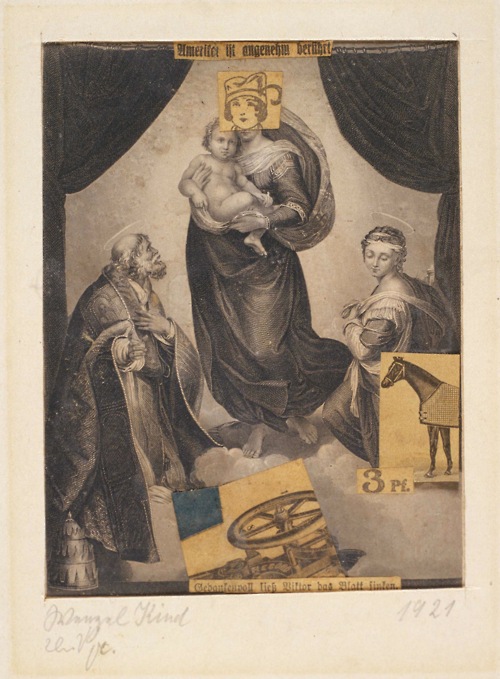
Knave Child
Kurt Schwitters, 1921
Collage on paper
Sprengel Museum, Hannover.
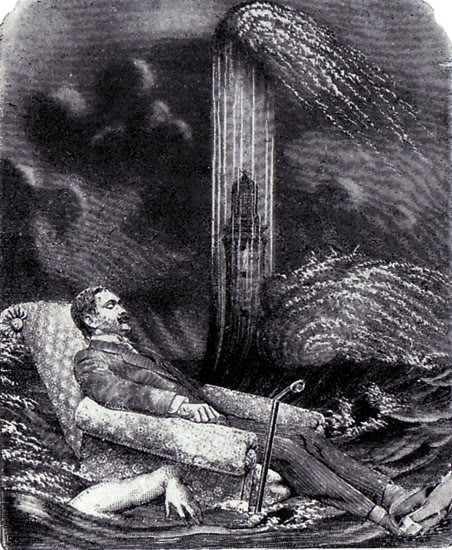
plate from La Femme 100 Têtes
Max Ernst, 1929
Collage novel
Published Éditions du Carrefour, Paris
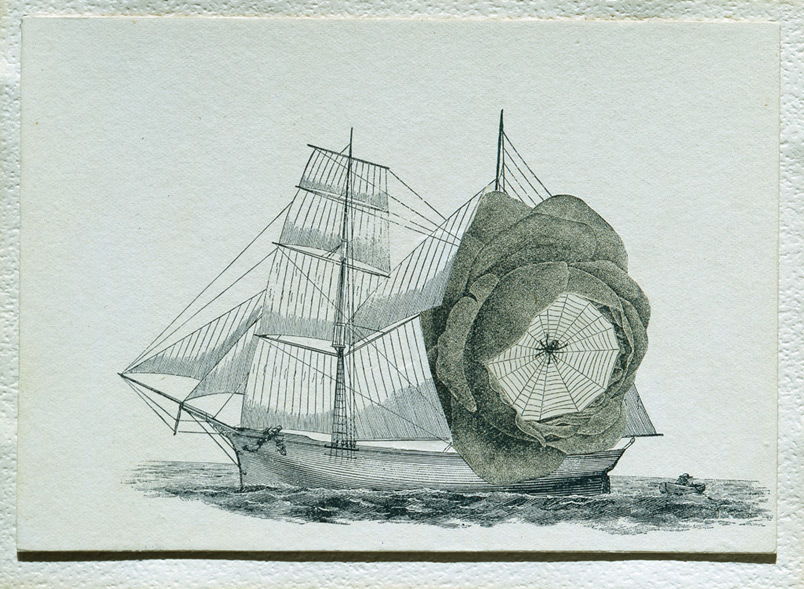
Untitled (Schooner)
Joseph Cornell, 1931
Collage on paperboard
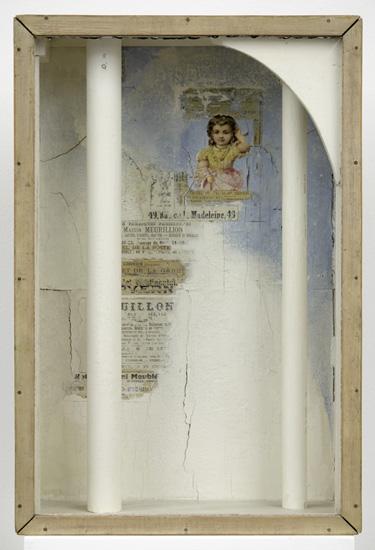
Untitled (Girl and Two Columns)
Joseph Cornell, c. 1950
Glass, wood, tempera and printed paper collage
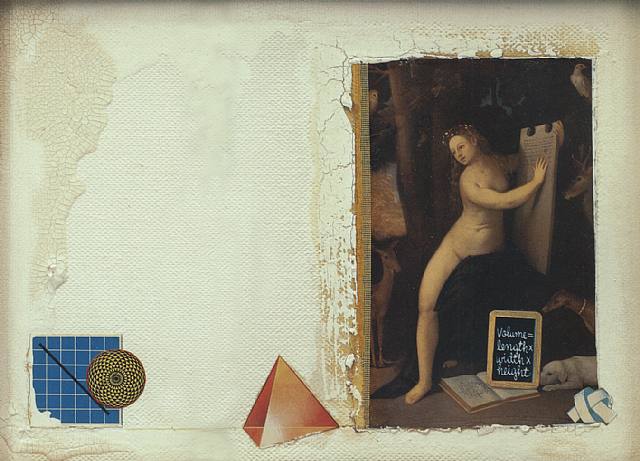
Circe III — Surface and Volume in Nature
Joseph Cornell, c. 1961-66
Collage on masonite
Posted in Assemblage, Collage, Dada, Expressionism, Illustration, Influences, Ingredients, J Cornell, K Schwitters, Links, M Ernst, Pop Art, Surrealism, Symbolism | No Comments »
Wednesday, January 9th, 2013
Collage for me is always an intimate viewing experience. You may find me with spectacles off and nose pressed near to the surface of any example within the medium. The scale of Diamonds in the Rough enhances the contrast between an up-close scrutiny and a step-back regard for the entire effect. With a large piece like this, I also enjoy visually cropping areas to create a series of virtual collage miniatures.
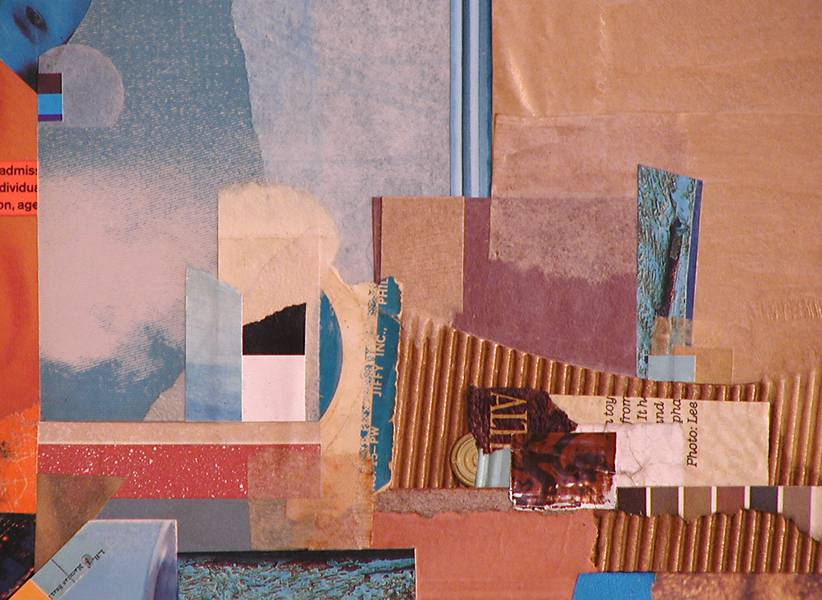
This micro view accentuates the ingredient elements, as in a collage miniature.
Visually, larger works are less ingredient centric, but still rely on their qualities.
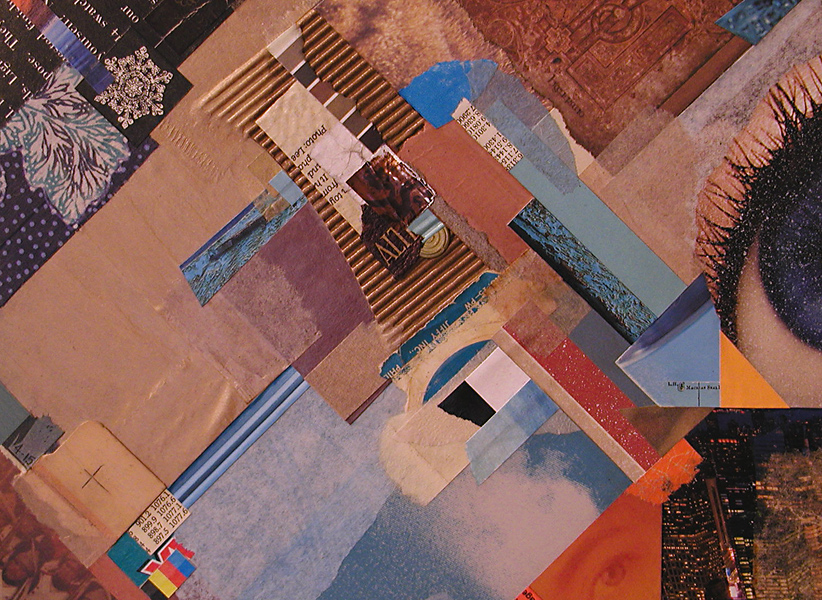
I think my imagination would never tire of working with diagonals.
What is it about the diamond or the triangle that engages my mind’s eye?
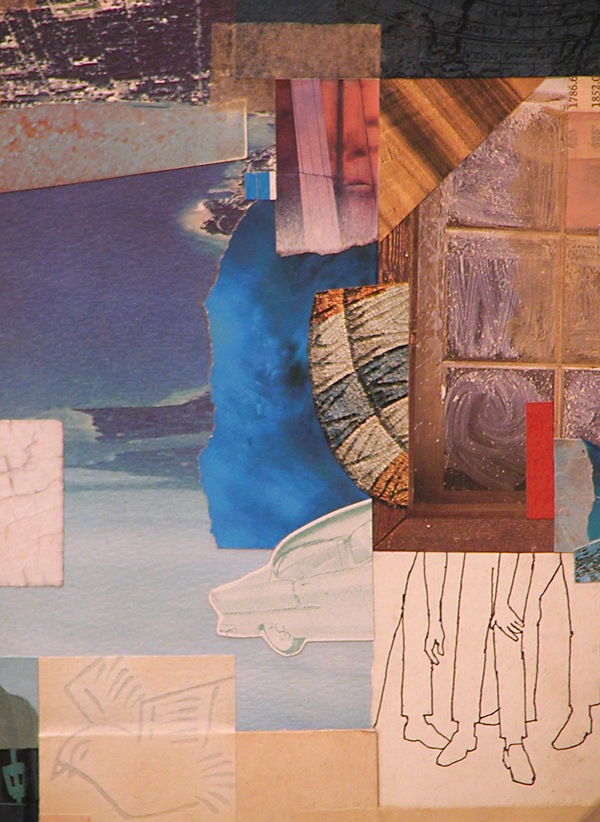
This is one of my favorite areas within the total artwork.
Oddly, the legs and hands resonate with the Tapley drawing in the exhibition.
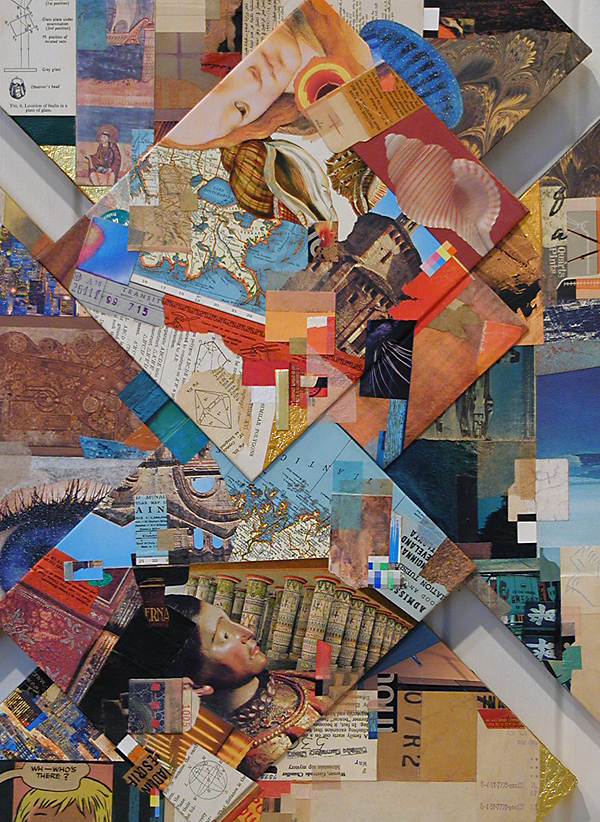
The composition’s focal center projects from the surrounding forms.
It differs energetically from the outer areas of structural perpendicularity.
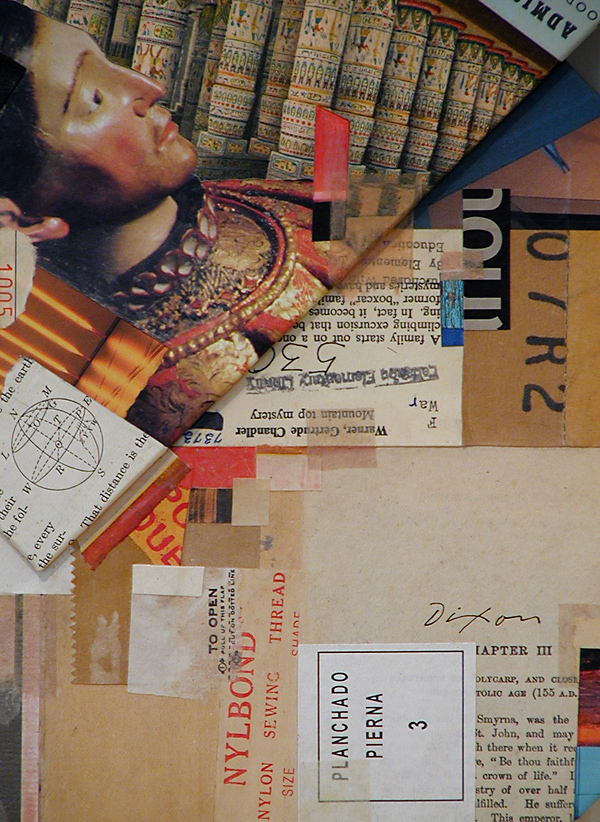
To regularly bestow a new purpose on found material . . .
Without fear of contradiction, one could say that I am hooked.
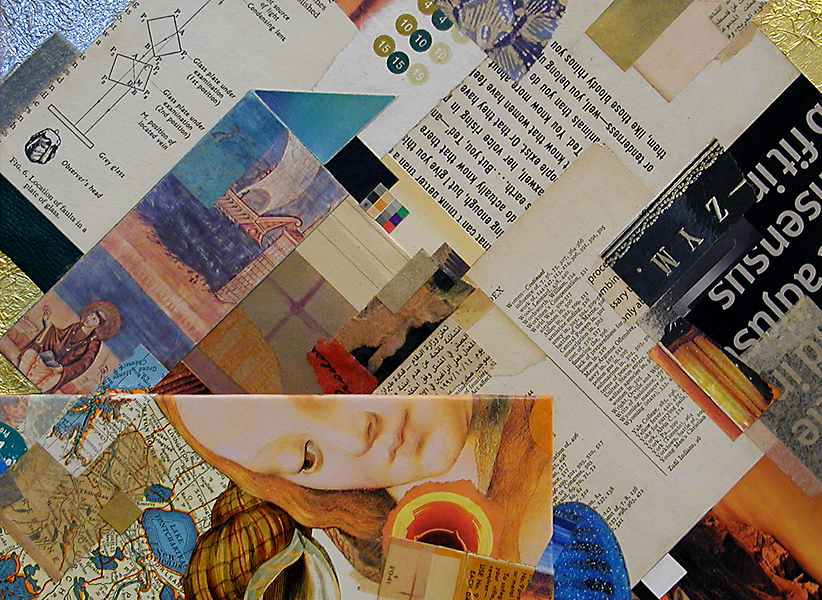
The essence of collage is the contrast of the mundane and sublime.
At any rate, this is often how I perceive it.
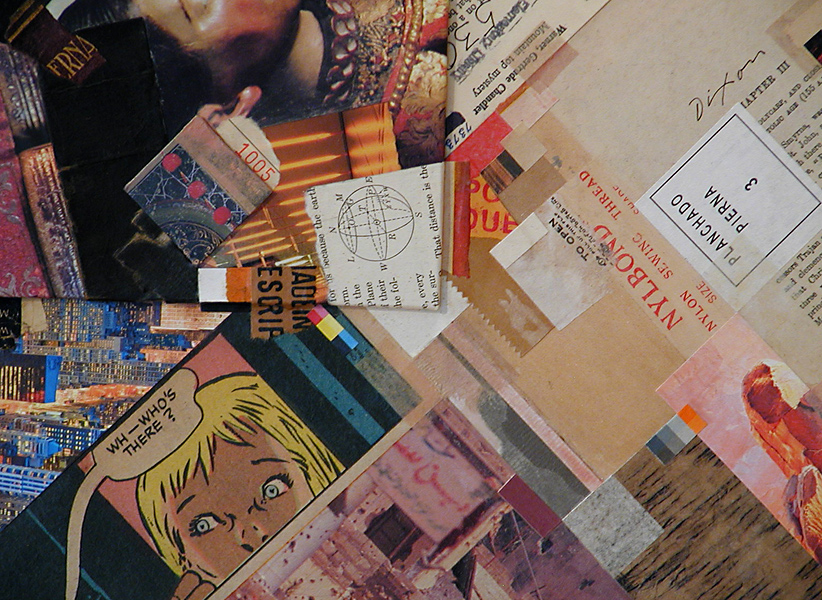
WH—WHO’S THERE? (Look closely: Milt Caniff, that’s who.)
Somebody saw this as an homage to Roy, but Kurt used comics first.
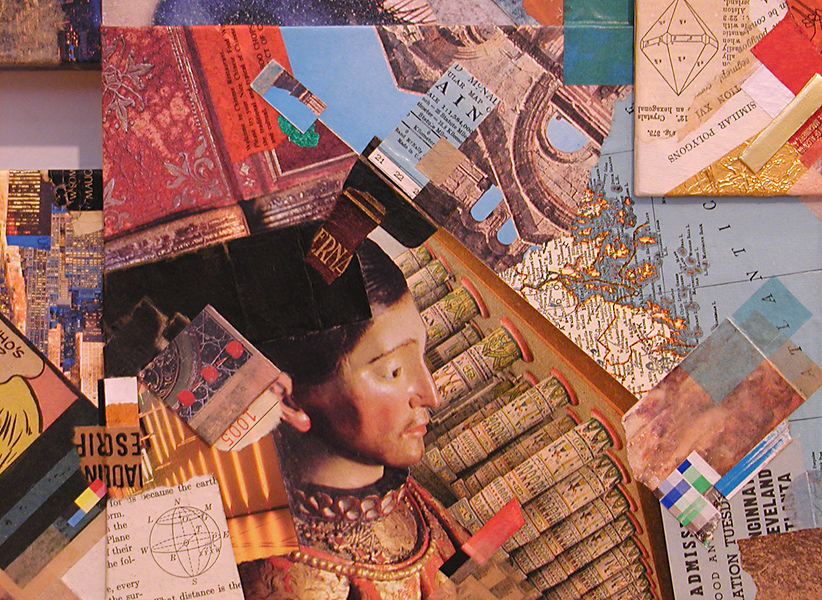
A collage can rest divertingly upon layers of symbolic meaning.
Or it can be simply the harmonious resolution of aesthetic factors.
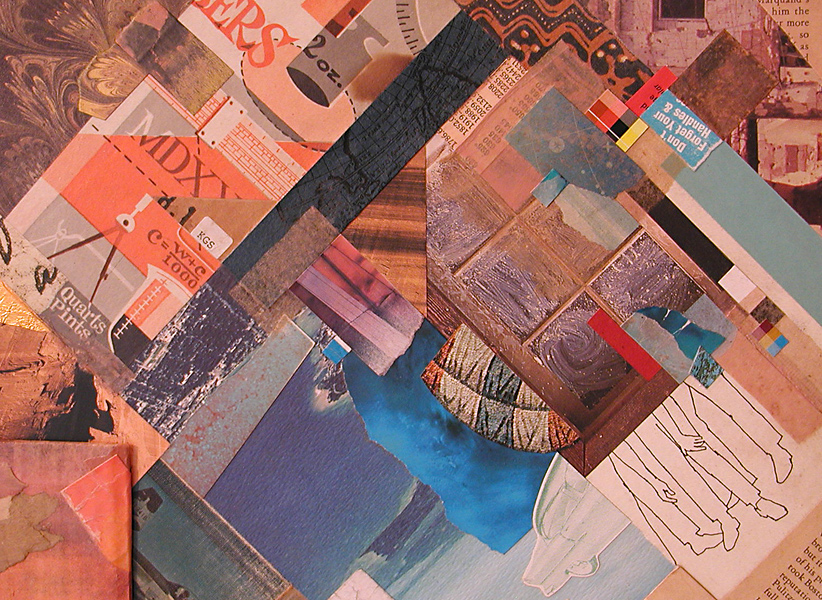
The dynamics of complementarity. (Is that a real word?)
More than one astute eye discovered my warm-cool “horizon.”
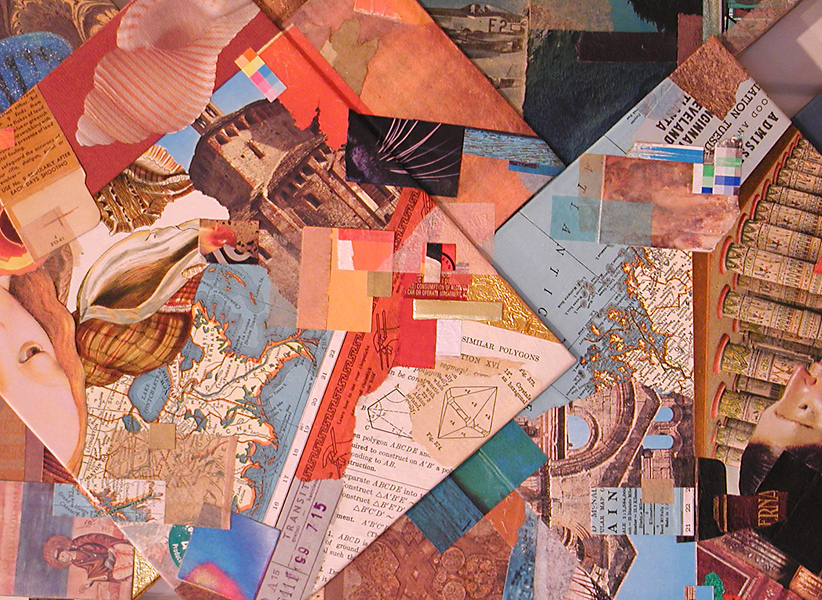
Composing with shape, color, contrast, rhythm, dimension.
At times, it need be about nothing more than that.
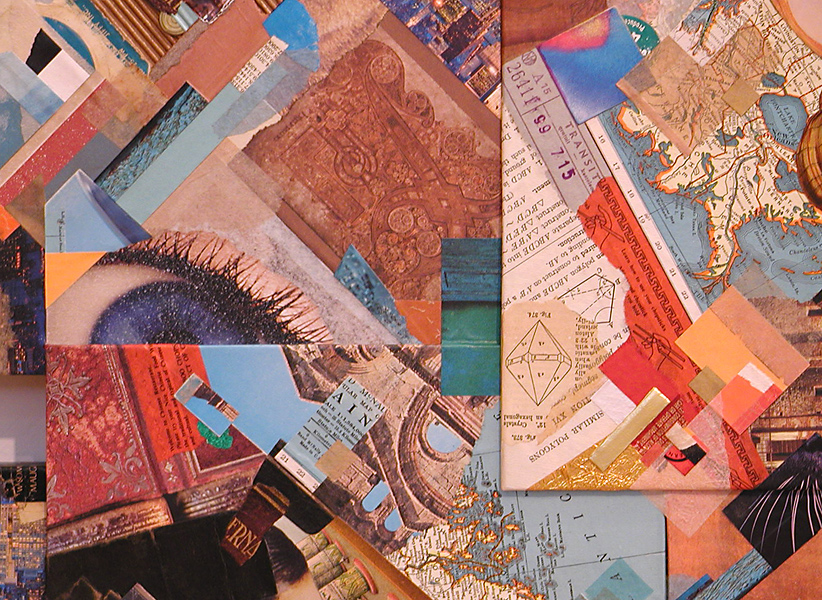
This image isolates a microcosm of the whole effect.
Are my larger works just a aggregation of collage miniatures?
Thanks for looking. Let me know what you think. Constructive criticism is encouraged at this site. To be honest, the medium of collage needs a bit more of it.
Posted in 1) Available!, Collage, Criticism, Details, Embedded Miniatures, Exhibitions, Ingredients, J A Dixon, K Schwitters, Larger Works, Methodology, R Lichtenstein, S Tapley | No Comments »
Saturday, December 8th, 2012
“He spread flour and water over the paper, then moved and shuffled and manipulated his scraps of paper around in the paste…. Finally, he removed the excess paste with a damp rag, leaving some like an overglaze in places where he wanted to veil or mute a part of the color.”
— Charlotte Weidler
It has been more than a year since I had the humbling opportunity to study dozens of Kurt Schwitters originals at the Berkeley Art Museum. I read the description by the art historian Charlotte Weidler that same day, but I only recently decided to experiment with the paste method she observed. I have always worked with a variety of adhesives, and I often combine more than one in a single collage, never hesitating to literally mix them together (white glue + acrylic varnish, for example). I was impressed with how good some of Kurt’s compositions had held together after 70 to 80 years. I dug out a small package of paper-hanger’s wheat paste acquired in the 1970s, with the new intention of using it to produce a collage on canvas that would stand on its own as an object when finished. Although I expected to coat the final surface later with gel medium, for my first piece based on using the same adhesive as the pioneering artist, I was mainly interested in how wheat paste would affect my process.
The artwork is undone, but I share one of my separate experiments below. I could not be more pleased with the results of this approach. The paste dries slowly. This allows for repositioning, easy removal of excess, and it cures to a flat, velvety finish. I am especially pleased with how conducive it is to manipulating coated paper torn from magazines, an ingredient I am quite fond of. I lightly sand the reverse side, adding a bit of white glue to the paste for good measure, and, using this hand-pasting technique, I have never found “mag scrap” more easy to work with. It may not seem like a big deal to those who attend diverse workshops and demonstrations, but, as a self-taught collage artist, it feels like a significant breakthrough to me.
Now, the only question that remains is one of durability. The seminal works of K.S. show every sign of lasting a century in decent shape, but I am no museum expert, nor have I been as fixated on archival longevity as some collage artists I know. I expect my creations to age, perhaps in unexpected ways. This reminds me of an online discussion not long ago about using elements taken from newspapers. Many collage artists may share my expectation that a newsprint ingredient will simply mature as nature sees fit, adding a certain “wabi-sabi” aspect to a work of art that relies on found material. Who knows what Picasso or Braque thought about the nature of impermanence when each created their first collage with that famous wood-grain paper found in a store? Or, for that matter, what Schwitters himself thought when— with seemingly little regard for acid-free niceties —he built the enduring concepts of Merz on the detritus of ordinary life?
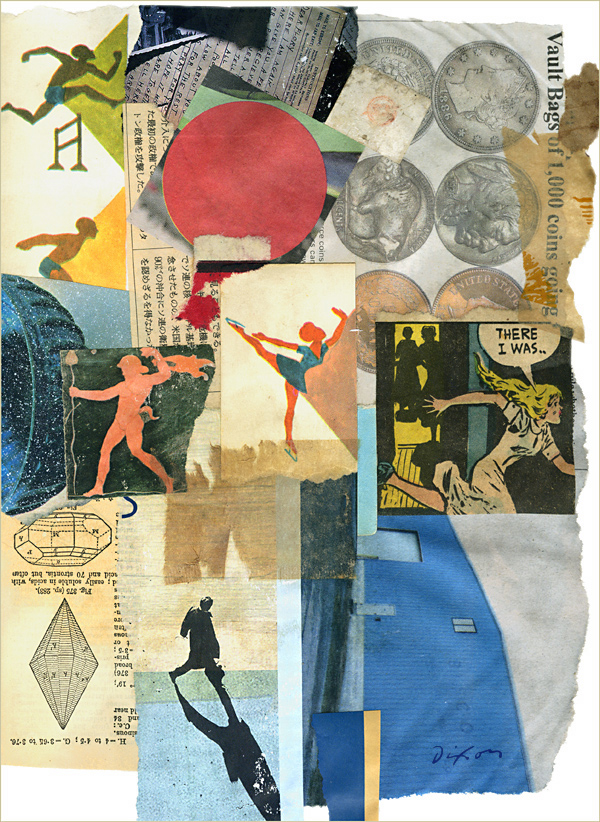
There I Was
collage experiment by J A Dixon
8.75 x 11.5 inches, not for sale
Posted in Collage, Demonstrations, Exhibitions, Experiments, G Braque, Influences, Ingredients, J A Dixon, K Schwitters, Merz, Methodology, P Picasso, Technique | No Comments »








































